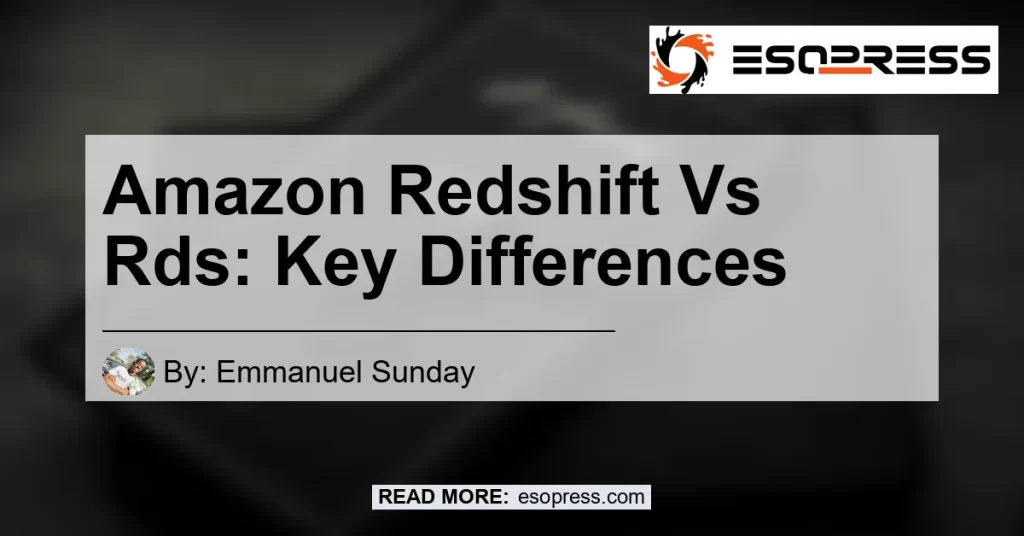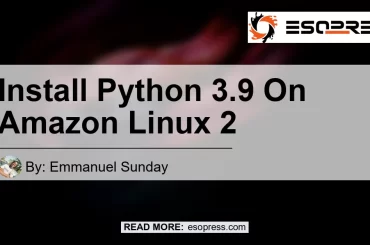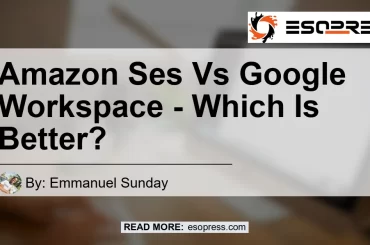

In the world of cloud computing, managing databases efficiently is crucial for businesses looking to maximize their data-driven strategies. Two popular services offered by Amazon Web Services (AWS) to handle database management in the cloud are Amazon RDS and Amazon Redshift.
While both services have their advantages and serve different purposes, it’s important to understand which one is the best fit for your specific needs. In this article, we will provide a comprehensive comparison of Amazon Redshift and RDS to help you make an informed decision.
Check out this Youtube video to compare and choose the best data management solution for your business needs: “RDS vs Redshift – YouTube.”
Contents
What is Amazon RDS?
Amazon Relational Database Service (RDS) is a fully managed database service that helps you set up, operate, and scale a relational database in the cloud. With RDS, you can choose from six popular database engines, including MySQL, PostgreSQL, MariaDB, Oracle Database, SQL Server, and Amazon Aurora.
RDS takes care of routine administrative tasks such as database setup, patching, backup, and recovery, allowing you to focus on building your applications.
Pricing
One of the major advantages of using Amazon RDS is its cost-effectiveness. RDS offers a pay-as-you-go pricing model, allowing you to only pay for the resources you consume.
The pricing starts as low as $0.017 per hour for MySQL, PostgreSQL, and MariaDB. However, it’s important to note that pricing can vary depending on the database engine and the AWS region you choose.
Scaling Capabilities
While Amazon RDS offers scalability options such as read replicas and automatic scaling, it is designed primarily for scaling vertically. This means that you can increase the size of your database instance to handle higher workloads, but there are limitations to horizontal scalability.
Use Cases
Amazon RDS is best suited for use cases where you need a traditional relational database system. It is ideal for applications that require ACID (Atomicity, Consistency, Isolation, Durability) compliance and strict data consistency.
Popular use cases for Amazon RDS include e-commerce platforms, content management systems, and enterprise applications.
What is Amazon Redshift?
Amazon Redshift, on the other hand, is a fully managed data warehousing and analytics service. It is specifically designed to handle large-scale analytics workloads and provide fast query performance on massive datasets.
With Redshift, you can analyze data using standard SQL queries and integrate with popular BI tools such as Tableau and Power BI.
Pricing
Compared to Amazon RDS, Amazon Redshift is generally more expensive due to its data warehousing capabilities. However, the pricing is still competitive compared to on-premises data warehouses.
Redshift pricing is based on the number of nodes in the cluster and the hours of usage, with options to scale up or down as needed.
Scalability
One of the key advantages of Amazon Redshift is its ability to handle petabyte-scale data warehouses and provide fast query performance. Redshift allows you to scale horizontally by adding and removing nodes to your cluster, making it a highly scalable solution for big data analytics.
Use Cases
Amazon Redshift is ideal for use cases where you need to analyze large volumes of structured data quickly. It is commonly used for business intelligence, data warehousing, and data analytics applications.
Industries such as retail, finance, and healthcare can benefit from the powerful analytic capabilities of Redshift.
Amazon RDS vs Redshift: The Key Differences
Now that we have discussed the basics of Amazon RDS and Redshift, let’s highlight the key differences between the two services:
Database Engine
Amazon RDS supports various relational database engines such as MySQL, PostgreSQL, and Aurora. On the other hand, Amazon Redshift uses a columnar data storage to support analytical queries on large datasets.
Performance
Amazon Redshift is optimized for fast query performance on large datasets. It uses columnar storage, parallel execution, and compression techniques to provide high-speed data processing.
While Amazon RDS can handle modest workloads, it may not be as performant as Redshift for complex analytics.
Scalability
As mentioned earlier, Amazon RDS is primarily designed for vertical scalability. It allows you to increase the size of your database instance, but there are limitations to horizontal scaling.
On the other hand, Amazon Redshift is built for horizontal scalability and can handle petabyte-scale data warehouses.
Use Case
The choice between Amazon RDS and Redshift depends on the specific use case. If you need a traditional relational database for your applications, Amazon RDS is the go-to option.
However, if you require fast query performance on large datasets for analytics purposes, Amazon Redshift is the recommended choice.
Conclusion: Our Recommended Product
After a thorough comparison of Amazon RDS and Redshift, our recommended product for businesses looking to analyze large volumes of structured data quickly is Amazon Redshift. With its powerful analytical capabilities, horizontal scalability, and optimized query performance, Redshift is the ideal choice for data warehousing and big data analytics applications. You can find the Amazon Redshift solution here.


Remember to choose the best option based on your specific needs and requirements. Whether you choose Amazon RDS or Redshift, AWS provides reliable and scalable solutions for database management in the cloud.
Happy data crunching!






